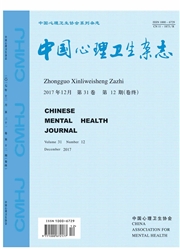

 中文摘要:
中文摘要:
目的:探索联合扩散张量成像(DTI)与认知功能指标识别轻度认知损害(MCI)与早期阿尔茨海默病(AD)的价值。方法:本研究被试来源于北京大学精神卫生研究所记忆中心病例库,所有被试完成简易精神状态检查(MMSE)、临床痴呆量表(CDR)、认知功能筛选测验(CASI)以及全套神经心理测查,并进行头颅磁共振成像三维结构相、DTI成像及液体衰减反转回复序列(FLAIR)成像,根据FLAIR图像选取白质外观正常的被试共64例(23例轻度AD患者、20例遗忘型MCI个体和21例健康对照),测定颞叶、顶叶、额叶、枕叶、海马旁回、前扣带回、后扣带回、胼胝体膝部、胼胝体压部等多个脑区白质的各向异性分数(FA)和平均扩散系数(MD)。结果:判别分析发现,顶叶、颞叶和胼胝体压部FA值能有效区分MCI组和正常对照组(Wilk’s λ=0.358,x2=38.51,df=3,P〈0.001),总判别正确率达87.8%,其中顶叶FA值对判别方程贡献最大(典则判别系数=1.002)。短时记忆与胼胝体压部MD值能有效区分轻度AD和MCI组(Wilk’s λ=0.261,x2=53.68,df=2,P〈0.001),总判别正确率达95.3%,其中短时记忆对判别方程贡献最大(典则判别系数=0.938)。结论:顶叶各向异性分数值对区分轻度认知损害组与正常对照,识别轻度认知损害有重要贡献;短时记忆联合胼胝体压部平均扩散系数能有效区分轻度阿尔茨海默病和轻度认知损害组,其中短时记忆有重要贡献。
 英文摘要:
英文摘要:
Objectives: To explore the individual and combined utility of diffusion tensor imaging measure- ments and cognitive performance in discrimination of amnestic mild cognitive impairment (aMCI) and Alzheimer" s disease (AD). Methods: Patients with aMCI (n = 20), mild probable AD (n = 23) and age-matched normal controls (NC, n = 21) who did not have visible white matter (WM) lesion burden were analyzed. All subjects were recruited from Peking University Institute of Mental Health Dementia Care and Research Center and administered with the Mini-Mental State Examination (MMSE), Clinical Dementia Rating (CDR), Cognitive Ability Screening Instru- ment (CASI), and a battery of neuropsychological tests. The study was performed using 3.0T MR/ scan- ner. Fractional anisotropy (FA) and mean diffusivity (MD) were measured in normal-appearing white matter (NAWM) using diffusion tensor imaging (DTI) with 64 encoding directions. Regions of interest included temporal WM, parietal WM, frontal WM, occipital WM, genu of corpus callosum WM, splenium of corpus callosum WM, parahippocampal fibers, anterior cingulate fibers and posterior cingulate fibers. Discrimination analysis was em- ployed to examine the potential indicators for detecting aMCI and AD. Results: FA values of parietal, temporal white matter and splenium of corpus callosum could differentiate aMCI and normal controls efficiently (Wilk's λ = 0. 358,x2 =38.51, df=3, P 〈0. 001), with 87.8% of discrimination accuracy. Score of short-term memory of CA- SI and the mean diffusivity of splenium of corpus callosum could differentiate mild AD from aMCI (Wilk's λ = 0. 261,x2 =53.68, df=2, P 〈0. 001) with 95.3% of accuracy. Conclusions: The FA value of parietal white matter could facilitate the detection of amnestic mild cognitive impairment compared to normal elderly, and short-term memory performance helps differentiate mild Alzheimer's disease from amnestic mild cognitive impairment.
 同期刊论文项目
同期刊论文项目
 同项目期刊论文
同项目期刊论文
 Microstructural White Matter Abnormalities Independent of White Matter Lesion Burden in Amnestic Mil
Microstructural White Matter Abnormalities Independent of White Matter Lesion Burden in Amnestic Mil Regional quantification of white matter hyperintensity in normal aging, mild cognitive impairment, a
Regional quantification of white matter hyperintensity in normal aging, mild cognitive impairment, a Regional pattern of increased water diffusivity in hippocampus and corpus callosum in mild cognitive
Regional pattern of increased water diffusivity in hippocampus and corpus callosum in mild cognitive Alterations in Regional Brain Volume and Individual MRI-Guided Perfusion in Normal Control, Stable M
Alterations in Regional Brain Volume and Individual MRI-Guided Perfusion in Normal Control, Stable M Apolipoprotein E epsilon4 Modulates Cognitive Profiles, Hippocampal Volume, and Resting-State Functi
Apolipoprotein E epsilon4 Modulates Cognitive Profiles, Hippocampal Volume, and Resting-State Functi Effects of Apolipoprotein E Allele and Age in Alzheimer’s Disease and Mild Cognitive Impairment in a
Effects of Apolipoprotein E Allele and Age in Alzheimer’s Disease and Mild Cognitive Impairment in a A correlativity study of plasma APL1beta28 and clusterin levels with MMSE/MoCA/CASI in aMCI patients
A correlativity study of plasma APL1beta28 and clusterin levels with MMSE/MoCA/CASI in aMCI patients Delayed help seeking behavior in dementia care: preliminary findings from the Clinical Pathway for A
Delayed help seeking behavior in dementia care: preliminary findings from the Clinical Pathway for A Frequency of the Apolipoprotein E epsilon 4 Allele in a Memory Clinic Cohort in Beijing: A Naturalis
Frequency of the Apolipoprotein E epsilon 4 Allele in a Memory Clinic Cohort in Beijing: A Naturalis 期刊信息
期刊信息
